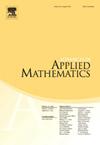d-Separated permutations and q-Stirling numbers of the first kind
IF 1.3
3区 数学
Q3 MATHEMATICS, APPLIED
引用次数: 0
Abstract
Let d be a nonnegative integer, a d-separated permutation is a permutation in which every two left-to-right minima are at distance greater than d. More precisely, for , suppose that are the left-to-right minima of π with and , then π is d-separated if for each j, . In this paper we study different enumerative properties on d-separated permutations. We first give a recurrence formula of the numbers of d-separated permutations in with exactly k left-to-right minima. Then we study the inversion and co-inversion polynomials of d-separated permutations, and give q-analogue and -analogue of for any d. Note that when , 0-separated permutations are just all permutations in , is Stirling number of the first kind, and the two polynomials and are both generalizations of q-Stirling numbers of the first kind. The q-Stirling numbers of the first kind when have been well studied by Médicis-Leroux and Cai-Readdy, who gave nice combinatorial interpretations via rook placements on a staircase chessboard. We give a bijection between permutations and rook placements in staircase chessboards.
第一类的d-分离排列和q-斯特林数
设d为非负整数,d分离置换是其中每两个从左到右极小值距离大于d的置换。更准确地说,对于π=π1π2⋯πn∈Sn,假设πi1,πi2,…,πik是π在k≥1且1=i1<i2<⋯<;ik≤n时的从左到右极小值,则对于每个j, 1<j≤k,如果ij−ij−1>;d,则π是d分离的。本文研究了d分隔排列的不同枚举性质。我们首先给出Sn中d分隔排列cd(n,k)的递推公式,从左到右的最小值正好为k。然后研究了d分离置换的反演多项式和共反演多项式,给出了任意d下cd(n,k)的q-analogue cqd(n,k)和(p,q)-analogue cp,qd(n,k)。注意,当d=0时,0-separated置换只是Sn中的所有置换,c0(n,k)是第一类Stirling数,两个多项式cqd(n,k)和cp,1d(n,k)都是第一类q-Stirling数的推广。当d=0时,第一类q-Stirling数已经被m -迪斯-勒鲁和凯-雷迪很好地研究过,他们通过在阶梯棋盘上放置车给出了很好的组合解释。我们给出了阶梯棋盘中排列和车的位置之间的关系。
本文章由计算机程序翻译,如有差异,请以英文原文为准。
求助全文
约1分钟内获得全文
求助全文
来源期刊

Advances in Applied Mathematics
数学-应用数学
CiteScore
2.00
自引率
9.10%
发文量
88
审稿时长
85 days
期刊介绍:
Interdisciplinary in its coverage, Advances in Applied Mathematics is dedicated to the publication of original and survey articles on rigorous methods and results in applied mathematics. The journal features articles on discrete mathematics, discrete probability theory, theoretical statistics, mathematical biology and bioinformatics, applied commutative algebra and algebraic geometry, convexity theory, experimental mathematics, theoretical computer science, and other areas.
Emphasizing papers that represent a substantial mathematical advance in their field, the journal is an excellent source of current information for mathematicians, computer scientists, applied mathematicians, physicists, statisticians, and biologists. Over the past ten years, Advances in Applied Mathematics has published research papers written by many of the foremost mathematicians of our time.
 求助内容:
求助内容: 应助结果提醒方式:
应助结果提醒方式:


